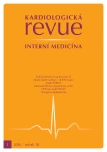Quality of life in patients with acute chronic heart failure decompensation evaluated using standardised questionnaires
Authors:
O. Ludka 1–3; M. Šenkyříková 1,2; R. Štěpánová 2,3; V. Musil 1,2; R. Štípal 1; Z. Pozdíšek 4; J. Špinar 1,2
Authors‘ workplace:
Interní kardiologická klinika FN Brno
1; Lékařská fakulta MU, Brno
2; Mezinárodní centrum klinického výzkumu, FN u sv. Anny v Brně
3; Kardiochirurgická klinika LF UP a FN Olomouc
4
Published in:
Kardiol Rev Int Med 2016, 18(1): 35-42
Category:
Cardiology Review
Overview
Background:
The increased incidence of chronic heart failure (CHF) is connected with modern diagnostic and therapeutic options and lengthening of lifespan. CHF is a serious disease which fundamentally influences life duration and quality of life, which is often more important for patients than life duration.
Methods:
Our study has been focused on patients with acute decompensation of chronic systolic heart failure. These mostly polymorbid patients have been tested for objective parameters and reported subjective difficulties. Standardised questionnaires (SF-12, short form of SF-36, SAQ – Seattle Angina Questionnaire, MLHFQ – Minnesota Living with Heart Failure Questionnaire, EQ 5D – European Quality of Life Questionnaire Version 5D and Karnofsky score) have been used for subjective evaluation and life quality assessment. All patients were tested after their health condition was stabilised at the time of discharge.
Results:
The mean value of the Karnofsky score in our research was 51.5 ± 20.7, identical for both genders and all NYHA categories. The mean total score of MLHFQ was 44.9 ± 19.5, with a difference between men and women (p = 0.044), and without difference between NYHA categories (p = 0.268). The mean total score of the physical part of MLHFQ was 20.3 ± 6.9, with a difference according to gender (p = 0.004), and without difference between NYHA categories (p = 0.306), the mean score of the emotional part of MLHFQ was 9.3 ± 6.0, identical for both genders and all NYHA categories (p = 0.102 and 0.295). Mobility tested by EQ 5D was limited in 65.6% of patients, and 39.3% of patients reported limited self-care. A total of 54.1% of patients had problems in performing their daily activities, whilst 60.7% patients reported pain and 47.5% anxiety and depression. The limitations of mobility and self-care were perceived more by females than males (p = 0.005 and 0.004). According to SAQ, 90% of patients felt chest pain when performing major physical activity. According to SF 12, 32.8% of patients with heart failure evaluate their own health condition as good and 34.4% as very bad.
Conclusion:
After the stabilisation of their health condition, patients admitted to the hospital for acute decompensation of CHF perceive a significant decrease in quality of life across the physical, emotional and social sphere. For this reason, questionnaires focused on life quality should become a standard part of the diagnostic procedure in patients with heart failure. The results will allow us to modify the therapeutic procedure taking into account the patients’ subjective feelings.
Keywords:
chronic systolic heart failure – quality of life – acute deterioration – standardised questionnaires
Sources
1. Křivohlavý J. Psychologie nemoci. 1. vyd. Praha: Grada Publising 2002.
2. Payne J et al. Kvalita života a zdraví. 1. vyd. Praha: Triton 2005.
3. Gurková E. Hodnocení kvality života pro klinickou praxi a ošetřovatelský výzkum. 1. vyd. Praha: Grada Publishing 2011.
4. Hudáková A, Majerníková L. Kvalita života seniorů v kontextu ošetřovatelství. 1. vyd. Praha: Grada Publishing 2013.
5. Trachtová E et al. Potřeby nemocného v ošetřovatelském procesu. 2. vyd. Brno: Institut pro další vzdělávání pracovníků ve zdravotnictví 2001.
6. Ludka O, Kára T, Drozdová A et al. Spánková apnoe a kardiovaskulární onemocnění. Kardiol Rev 2013; 15: 87– 93.
7. Reed J, Clarke CH, Macfarlane A. Nursing Older Adults. 1st ed. New York: Bell and Bain 2012.
8. Farcas AD, Nastasa LE. Quality of life patients with chronic congestive heart failure. HVM Bioflux 2011; 3: 239– 245.
9. Fotos NV, Giakoumidakis K, Kollia Z et al. Healt-related quality of life of patients with severe heart failure. A cross-sectional multicentre study. Scand J Caring Sci 2013; 27: 686– 694. doi: 10.1111/ j.1471-6712.2012.01078.x.
10. Hoekstra T, Lesman-Leegte I, van Veldhuisen DJet al. Quality of life is impaired similarly in heart failure patients with preserved and reduced ejection fraction. Eur J Heart Fail 2011; 13: 1013– 1018. doi: 10.1093/ eurjhf/ hfr072.
11. Britz JA, Dunn KS. Self-care and quality of life among patients with heart failure. J Am Acad Nurse Pract 2010; 22: 480– 487. doi: 10.1111/ j.1745-7599.2010.00538.x.
12. Šafránková A, Nejedlá M. Interní ošetřovatelství I.1. vyd. Praha: Grada Publishing 2006.
13. Pokorná A. Efektivní komunikační techniky v ošetřovatelství. 3. vyd. Brno: Národní centrum ošetřovatelství a nelékařských zdravotnických oborů 2010.
14. Papadopoulou EF, Mavrogeni SI, Dritsas A et al. Assessment of quality of life using three activityquestionnaires in heart failure patients aftermonthly, intermittent administration of levosimendan during a six-month period. Hellenic J Cardiol 2009; 50: 269– 274.
Labels
Paediatric cardiology Internal medicine Cardiac surgery CardiologyArticle was published in
Cardiology Review

2016 Issue 1
Most read in this issue
- Proton pump inhibitors – new molecules, new knowledge
- What to use in patients with ischaemic heart disease and atrial fibrillation – anticoagulation, antiaggregation or both?
- Hyperuricaemia, cardiovascular diseases and heart failure
- Cardiac cachexia
